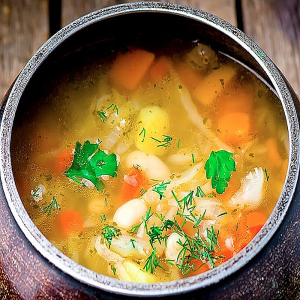Stalin's Daily Cabbage Soup
 Garanties sécurité
Garanties sécurité
(à modifier dans le module "Réassurance")
 Politique de livraison
Politique de livraison
(à modifier dans le module "Réassurance")
 Politique retours
Politique retours
(à modifier dans le module "Réassurance")
Stalin's Daily Cabbage Soup
In Soviet times, daily cabbage soup was a popular dish prepared successfully. Among the cooks, the most famous and delicious recipe was the one prepared especially for Joseph Stalin.
I suggest you recreate this cabbage soup by following the traditional recipe. The process isn’t particularly quick, but the result is well worth it: an incredibly flavorful soup.
Ingredients for the broth:
- Veal breast or ribs: 400 g
- Mature beef breast: 400 g
- Soup chicken: 600 g
- Onions: 150 g
- Carrots: 100 g
- Parsley root or parsnips: 60 g
- Bay leaves: 2 pcs.
- Allspice berries: 3 pcs.
- Black peppercorns: 6 pcs.
- Cloves: 2 buttons
- Salt: to taste
- Drinking water: 3 l
Preparing the broth:
- Clean the meat and place it in a large pot.
- Cover with water and bring to a boil over high heat. Skim off any foam.
- Add the roots and let the broth simmer over low heat for 1 hour.
- Afterward, remove the vegetables. Add salt to the broth and continue simmering at a minimum boil for another hour.
- Filter the finished broth. Remove the meat from the bones and place it back in the broth. Discard the bones.
Preparing the cabbage:
- Sauerkraut (very spicy): 1.5 kg
- Onions: 350 g
- Melted butter: 60 g
- Caraway seeds, dill, cloves, allspice: to taste
- Finely chop the onion and sauté it in butter until tender.
- Add the finely chopped sauerkraut and spices to the pan. Sauté for about 20 minutes.
- Transfer the sauerkraut to an ovenproof dish, uncovered.
- Place in a preheated oven at 200 ºC for 10 minutes. Then, reduce the temperature to 100 ºC and simmer the cabbage for 3 to 4 hours. It should darken and acquire a reddish-brown hue.
Preparing the seasonings for the cabbage soup:
- Fresh cabbage: 400 g
- Carrots: 150 g
- Celeriac or parsnips: 100 g
- Melted butter: 30 g
- Salt and pepper: to taste
- Chop the fresh vegetables.
- Sauté the carrots and parsnips in butter until tender.
- Add the braised sauerkraut to a large pot with the broth.
- Incorporate the fresh cabbage and sautéed vegetables. Season with salt and pepper to taste.
- Let the soup simmer over low heat for 2 hours.
Freezing the soup:
- Let the soup cool down.
- Pour it into a freezer-safe container and place it in the freezer for 12 to 16 hours.
- Once frozen, allow the soup to thaw completely at room temperature.
Final cooking of the cabbage soup:
For 4 jars of 500 ml, you will need:
- Ham: 150 g
- Boiled pork: 150 g
- Garlic: 40 g
- Puff pastry: 500 g
- Egg yolk: 1
- Rub the inside of the jars with crushed garlic.
- Place the ham and pork in each jar.
- Add the cabbage soup and seal the jars with the puff pastry. Brush the pastry with the beaten egg yolk.
- Place the jars in a preheated oven at 160 ºC and cook for 1.5 hours.
Serving:
Serve the finished cabbage soup with green onions, sour cream, fresh herbs, and aromatic rye bread.
This recipe will allow you to taste a dish rich in history and flavor, just as it was served to Stalin. Bon appétit!
The Origin of Stalin's Daily Cabbage Soup Recipe:
The origin of the recipe for Stalin's daily cabbage soup dates back to the time when Joseph Stalin was in power in the Soviet Union. The dish was prepared by Anastasios Makharadze, a famous Georgian chef who served as Stalin’s personal cook.
Anastasios Makharadze, originally from Georgia, was known for his expertise in traditional Georgian and Russian cuisine, but he was particularly famous for the way he prepared meals for the Soviet dictator. According to historical accounts, Stalin was a difficult man when it came to food and had specific preferences for the dishes served to him. Among his favorite meals was this cabbage soup, which was carefully prepared down to the smallest detail to suit his tastes.
The chef, who was trained in both Russian and Georgian culinary schools, had a special talent for combining simple yet flavorful ingredients to create dishes that were both nourishing and refined. Stalin's cabbage soup was therefore much more than a simple dish: it was a symbol of wealth and power, and became a daily staple in the life of the dictator.
The secret of this recipe lies in the perfect combination of meats, spices, and slow cooking techniques. The different types of meat (veal, beef, and chicken), along with the sauerkraut slowly braised in the oven, provided a depth of flavor that Stalin particularly appreciated. The soup was also a hearty dish, ideal for the long Russian winters.
In summary, Stalin’s Daily Cabbage Soup was created by Anastasios Makharadze, a chef who knew Stalin’s tastes perfectly and was able to adapt both Georgian and Russian cuisine to create a dish worthy of the Soviet power table. This recipe combines tradition, history, and the precision of a chef who knew how to satisfy his demanding employer.


